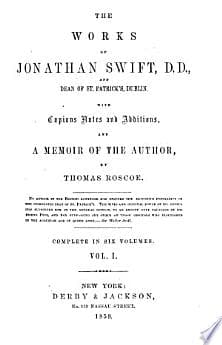- Published on
The Works of Jonathan Swift
- Authors

- Name
- Jonathan Swift
- @search?q=Jonathan Swift

Overview:
Gullivers Travels, authored by Jonathan Swift in 1726, is a satirical novel that recounts the story of Lemuel Gulliver, a ships surgeon who embarks on several voyages, encountering strange lands and societies that serve as a critique of human nature and contemporary society.'
Key Themes:
- The Nature of Man: Swift explores the duality of human nature, portraying both the pettiness and nobility that coexist within humanity.
- Political Satire: The novel critiques the political landscape of Swift's time, including the petty squabbles of European states and the corruption within English politics.
- Exploration and Discovery: Reflects on the human impulse for exploration and the consequences of encountering the unknown.
- Societal Critique: Through the various societies Gulliver encounters, Swift comments on the flaws of social constructs and the folly of human pride and prejudice.
Plot Summary:
- Lilliput: Gulliver finds himself in a land of miniature people where he is initially a curiosity and then a tool in their political machinations.
- Brobdingnag: A realm of giants where Gulliver is the tiny curiosity, offering a reversed perspective on human society.
- Laputa and the Flying Islands: Satirizes the impracticality of theoretical knowledge disconnected from practical life, critiquing the Enlightenment's emphasis on reason.
- Houyhnhnms and Yahoos: Gulliver encounters a society of rational horses, the Houyhnhnms, and the brutish human-like Yahoos, leading him to question the virtue of human society.
Impact and Legacy:
Gulliver's Travels is celebrated for its wit, imaginative storytelling, and its keen analysis of human nature and society. It remains a seminal work in the canon of English literature, influencing countless works of satire and fantasy that followed.
